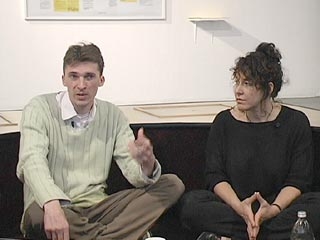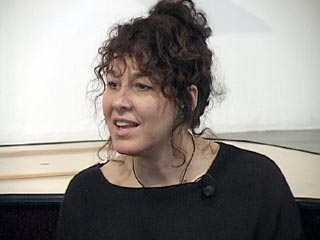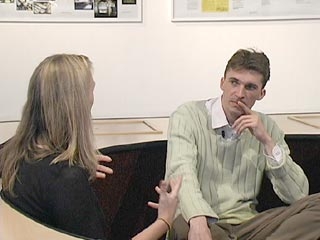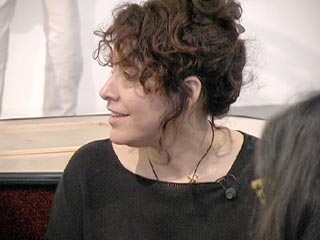Feature: Conversations
Nicolas Bourriaud and Karen Moss
In Part II of our conversation with Nicolas Bourriaud, a curator at the Palais de Tokyo in Paris, and Karen Moss, Director of Exhibitions and Public Programs at the San Francisco Art Institute, we continue discussing how architectural, institutional, curatorial, educational and economic structures need to change to facilitate the new forms of art production. If you missed Part I, you can catch up here.
Karen Moss I think a lot of museums are rebuilding their buildings, because they are realizing again that the architectural imperative is not conducive to doing this kind of work.
Stretcher So what kind of architecture would be appropriate?
Nicolas Bourriard Any. It’s not the shape – it’s what you do within the shape.
KM I meant places that still have very small discrete galleries that are not flexible. You have to activate them.
NB Exactly – it’s what you do inside.
Stretcher Is the new curatorial studies program here going to reflect this kind of thinking? And what would you say to those who think that curatorial studies programs are a less serious program than art history programs?
KM Curatorial studies programs need to exist now is because contemporary artists are so diverse. If you’re working with living artists, you’re dealing with a completely different set of power structures and processes than if you’re working with historical material. Before, the curator was there to merely select from what an artist had already produced. In the contemporary context, if you’re working with artists who are working with different forms, it’s more of a collaboration, a negotiation, a co-production. I was really lucky because my first curatorial internship was at Berkeley Art Museum when David Ross was the curator, so I learned the administrative aspects of an exhibition in a way that was quite different than it would have been in a traditional museum. One of the very first things I did when I was there was work on a Terry Allen and Jo Harvey Allen performance series. I had to find a regulation boxing ring and four-inch spike-heeled shoes for Jo Harvey Allen. That’s not typical curatorial practice.
Stretcher Is that true for your work also, Nicolas?
NB Absolutely.
KM I can think of a very specific example. We originally wanted to Christine Hill to do a walking tour of San Francisco. You heard in her talk the other night that she’s set up a tour guide office in Manhattan. Unfortunately the time frame did not allow her to spend the amount of time that she would have needed in order to really get to know San Francisco. The whole point of that project is that she spends a lot of time getting to know, inside out, every tiny aspect of the neighborhood so the tour becomes more about the idiosyncratic qualities. And we have a lot of idiosyncraties in this neighborhood. There was a negotiation about doing a different project that would be more site specific, more conducive to this environment. And because Christine does not create objects, there is also a negotiation about what an artist is paid for their time and their work. The issues are production and labor, not about commodity objects, which is also interesting.
Stretcher How do the economics or economic relationships or structures in museums need to change to facilitate this different kind of art production?
KM Nicolas and I have very different situations in our respective institutions. An art school allows a certain freedom. We are not dependent on selling objects in the Walter McBean Galleries, nor on supporting the program for a public that is coming to consume. We are here primarily for students; for the larger public, we offer an educational opportunity to learn something new about art that they would not necessarily see in a commercial gallery or a larger non-profit space such as a museum. So, it’s a great luxury. On the other hand, it presents challenges because our budgets are not at the same level that one would have in a larger museum. Nicolas, maybe you should talk about your arrangement with the Palais de Tokyo.
NB Again, it’s a non-profit organization which is important. It’s the same symbolic structure as any French museum. But the fact is, we are totally free from any political power. I’m not employed by the government, I’m employed by an association which is totally different. My boss is the board and actually we set the board up ourselves.
KM You’re able to choose your own bosses.
NB That’s what we did – literally. It was an exciting opportunity to set up an organization from scratch which is something you never normally have. Normally, you integrate into something, you’re in the middle of a process and then you have to cope with what your predecessors did. I didn’t have this problem.
KM The American system is very different from France’s national museum system, where everything is part of a ministry. American museums have changed considerably in terms of the market and marketing. And I think one of the most difficult things about being in a large museum in this country is that you do not have the government sponsorship that you have with the national museum system. Museums here are largely driven by private contributions since the government monies are less available. Private contributions are largely driven by marketing efforts and also by what we euphemistically call "alternative revenue" which means bookstores and cafés. The problem with American museums is that at the same time they’re trying to expand audiences, they are becoming sites of commerce and consumption, particularly in the arena of the bookstore and the café. That’s not necessarily bad, but it does put pressure on curators, because marketing forces and the forces of development are always knocking on one’s door.
NB We all know that the most important things in art history in the last forty or fifty years were not popular. So what do we do?
KM Using the commercial places in a museum could be really productive. It can create a locus. I think for instance, that Benjamin Weil [new media curator at the San Francisco Museum of Modern Art] has used the social space, like the lobby, for various events. When I was at the Walker Art Museum, we were very successful in dovetailing the programs that the curators were generating with spaces that allowed a greater flow between different activities.
NB For me, the restaurant and the bookshop are an important part of the project. Super important. We are trying to develop very interactive situations, between the boutiques and café and the activities of the space of the art center. What is now the restaurant will be transformed into a self-service café. And then next December we’ll have the real restaurant open on the Avenue of President Wilson. It’s important to provide visitors with books, objects, games – whatever – as kind of a sweet preceding the medicine.
Stretcher This is probably oversimplifying things dreadfully. I have a European friend who says artworks like those in this show [Touch, an exhibition informed by Bourriard’s theory of relational aesthetics] are commonly shown in Europe. Whereas here ...
NB That is optimistic!
Stretcher Nostalgic, maybe.
KM I think it’s true. Someone like Ben Kinmont [an artist in Touch] says that he’s been’s showing almost exclusively in Europe, although he lives in the United States.
NB He had a show in New York – but I curated it actually.
KM Many of these artists whose work is more relational, performative, emphemeral, or interhuman are not as well-accepted in the context of the strictures at American institutions. The other thing is Americans have an edifice complex. It’s so often about the building and the social aspects, like who patronizes the museum, and I don’t know how you change that, because that’s a much bigger cultural shift. It really gets backs to an educational problem.
NB On the other hand, the European idea of America is that people here are very much more receptive to new things, new ideas.
KM I do think people are open here – especially younger people. But I also think there are issues about who goes to museums. You told me a very interesting story about the fact that, because you’re open from noon to midnight, lots of people who don’t normally go to museums – like everyday workers – go into the museum. I am curious about what their reactions to the art.
NB It really depends – there’s no typical reaction to it – that’s the lesson also – the reaction is totally diverse.
KM But you have a very diverse audience too. There’s no specific age range.
NB Not really. I have the results of a study of the audience of Palais de Tokyo, but it doesn’t give many clues about the typical visitor. It’s very balanced between ages and social conditions, etc. It’s mainly Parisians and foreigners, more than the people from the rest of France.
KM That says something. We were having a conversation about all the activities that are being organized in upstate New York around the place that David Ross is doing up in the Hudson River Valley and they were saying the profile of the visitor there was likely to be New York City people or foreign travelers. The point is that the average American is not as educated in the arts and so it’s a harder thing to say, "if we open our museums from noon to midnight that we will get a much more diverse audience", because there is still that educational issue.
NB On the other hand, being educated in the arts doesn’t mean that you can more easily understand the art works which are, for example, in this room. Sometimes it just makes them think "this is not art" because they think they know what art is. It can be good also not to know anything about art.
Stretcher Let’s go back to the idea of economics for a just a little bit; we’ll play devil’s advocate for a moment. Let’s say an artist makes an object that someone wants to buy. They want it, give the artist money – that’s the base of one kind of economic structure. It seems as if relational aethetics involves an underlying assumption that the money comes from somewhere else, like maybe government funding or granting. What actually becomes the economic structure through which the artist is supported?
NB The funny thing is that most of the works here belong to private collections.
Stretcher But, at the roundtable discussion you made the point that this is the after-effects of the actual piece of art. The transaction is the actual piece of art.
NB What do you buy when you buy an artwork? Do you buy shape and colors or do you buy an experience? You buy an experience – otherwise you can buy anything else. If you’re buying an experience, then this experience can take many, many forms and it doesn’t necessarily have to be an object. It can be something you can use, it can be something you have to do. There are many possibilities that feed the relationship between the artist and the collector, or the artist and the museum curator.
KM A lot of artists are utilizing the issue of service, like Christine Hill. The first time you met her, Nicolas, she gave you a back massage. Now she’s "shown" the Volksboutique in various forms. So it’s about performing the service. Her personal economy revolves around her different "organizational ventures" and the fees she’s paid as an honorarium for a service.
NB Criticizing this kind of art because it doesn’t provide an object would mean that any enterprise which doesn’t produce objects is irrelevant which is not the case. It doesn’t work that way in real life. So why would it work that way in the art world?
KM But speaking of the art world, the other interesting part of this show from an historical vantage point, is the early 1990s was the time when the art market crashed and so it allowed a certain freedom on the part of younger artists not to worry about some superstructure of the market because the market had collapsed so they started their own galleries
NB Which was the case in the 1970s, also.
KM The other interesting aspect of artists in this show is they don’t have the same issues that artists from the 1960s and 1970s had about making a living through their art. Some of the artists who have the anchor pieces in the show have major gallery representation and are shown in major international exhibitions. They may have started out quite anti-commodity or ephemeral, but at this point it’s less of a problem for them to be represented and sell their work. There are some younger artists in the show for whom that’s not the situation – who explicitly do not have representation by choice. They show with galleries, but they’re not represented.
Stretcher That’s the question – the gallery structure as we now know it is a collecting structure. And is that an appropriate economic interface?
NB I think yes. Absolutely. If you’re a good gallerist you don’t sell a painting as an object. If you do, you’re really a bad gallerist. You sell it for what it is which is a really complex and rich network of the idea of experience, the idea of history, ways of thinking, etc. It is not only an image on a canvas.
KM Which is why the collector is someone who buys the art because they understand it’s one of many nodes on that network as opposed to something to be consumed for monetary value. Which takes an enlightened collector.
Stretcher Anything else?
KM It’s really interesting to utilize this pitbed.
NB Welcome to the Moss Mansion!





